The 7 Most Representative Animals of the Amazon


Written and verified by the veterinarian and zootechnician Sebastian Ramirez Ocampo
Ranked as one of the 7 natural wonders on our planet, the Amazon covers almost 40% of the entire southern region of the American continent. It extends to 9 different countries, and is home to about 10% of the planet’s biodiversity known so far.
In this article, we’ll explore the bodily characteristics, habitat, abilities, and feeding habits, as well as the reproduction of some of the most representative animal species of the Amazon. Don’t miss it!
The most representative animals of the Amazon
The world’s largest tropical forest is home to about 425 species of mammals, 427 amphibians, 371 reptiles, 1,300 birds, and at least 2,406 fish. This is according to the Amazon Assessment Report 2021, which states that these numbers are approximate underestimates of the true richness of the Amazon.
This report warns that the rate of discovery of new species of animals and plants is quite high: one every two days. Here are some of the mammals, reptiles, amphibians, and insects that are considered the most iconic of this great region of the planet, due to their peculiarities and popularity.
1. Pink river dolphin (Inia geoffrensis)
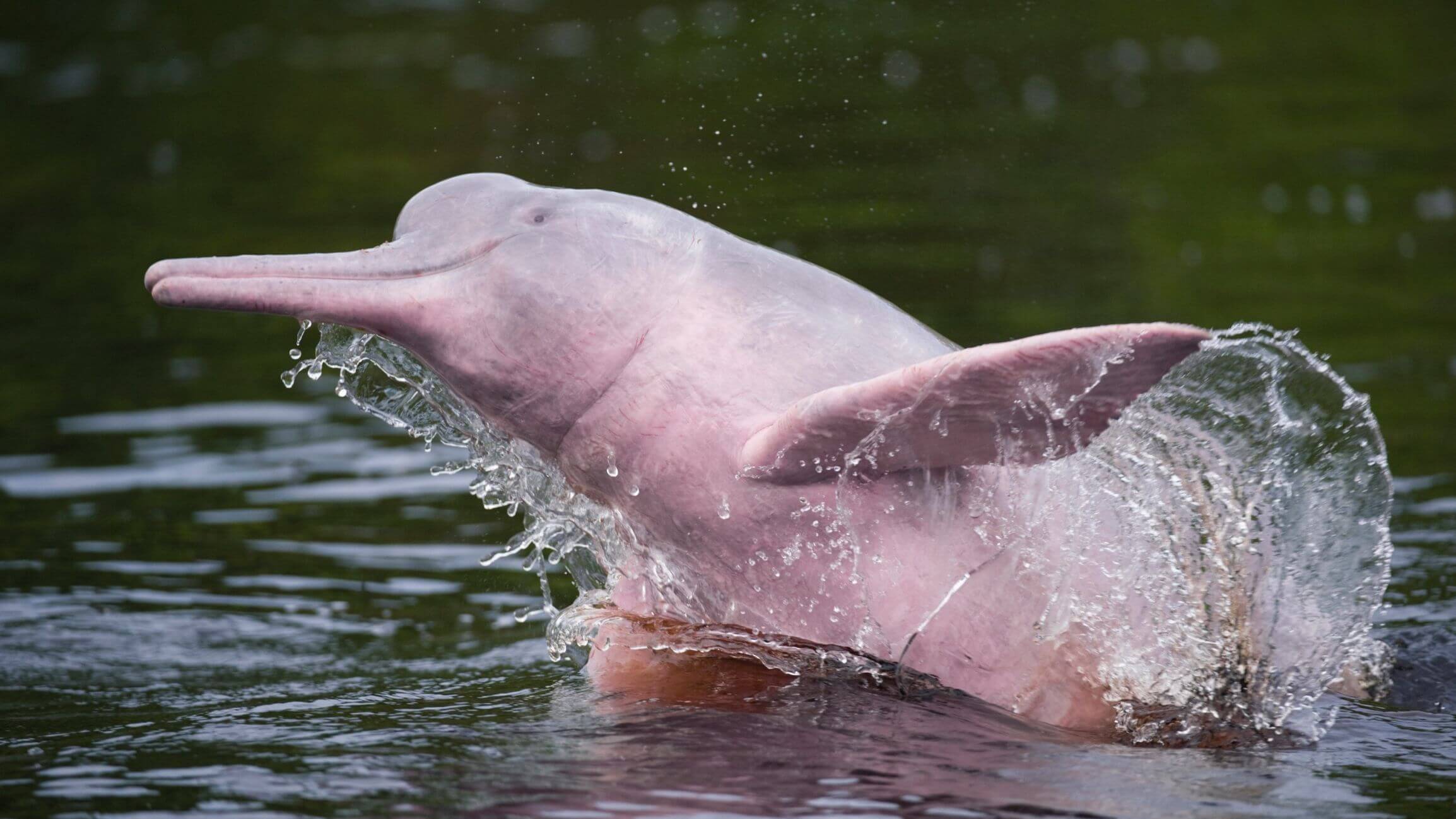
This is the largest and most intelligent species of freshwater dolphin in existence. As adults, they can reach 2.5 meters (6.5 feet) in length and 200 kilograms (440 lbs) in weight.
Unlike their oceanic cousins, this cetacean has very different physical characteristics. On the one hand, its head is larger and its snout is much longer and pointed. In addition, since their cervical vertebrae aren’t fused, they can turn their heads through 180°.
The most outstanding aspect of this species is the coloration of its body, with gray and, above all, pink tones. At birth, these dolphins are gray, but acquire the pink color as they reach adulthood. Although the origin of this phenomenon isn’t clear, the most accepted theory indicates that it’s a product of the wear and tear of the skin over the years.
Its habitat within the Amazon basin is located between the fluvial systems of the Orinoco River and the upper reaches of the Madeira River in Bolivia. They feed on up to 43 different fish species such as piranhas, catfish, and corvina.
Due to the turbidity of the water in these areas, pink dolphins locate their prey by echolocation. According to a study in the Journal of Experimental Biology, these animals emit short-range and high-frequency sound waves through their clicks.
Regarding reproduction, females give birth to a single calf after 12 months of gestation. The dolphin remains with its mother for at least 2 years. In nature, its life expectancy can be up to 30 years.
2. Capybara (Hydrochoerus hydrochaeris)
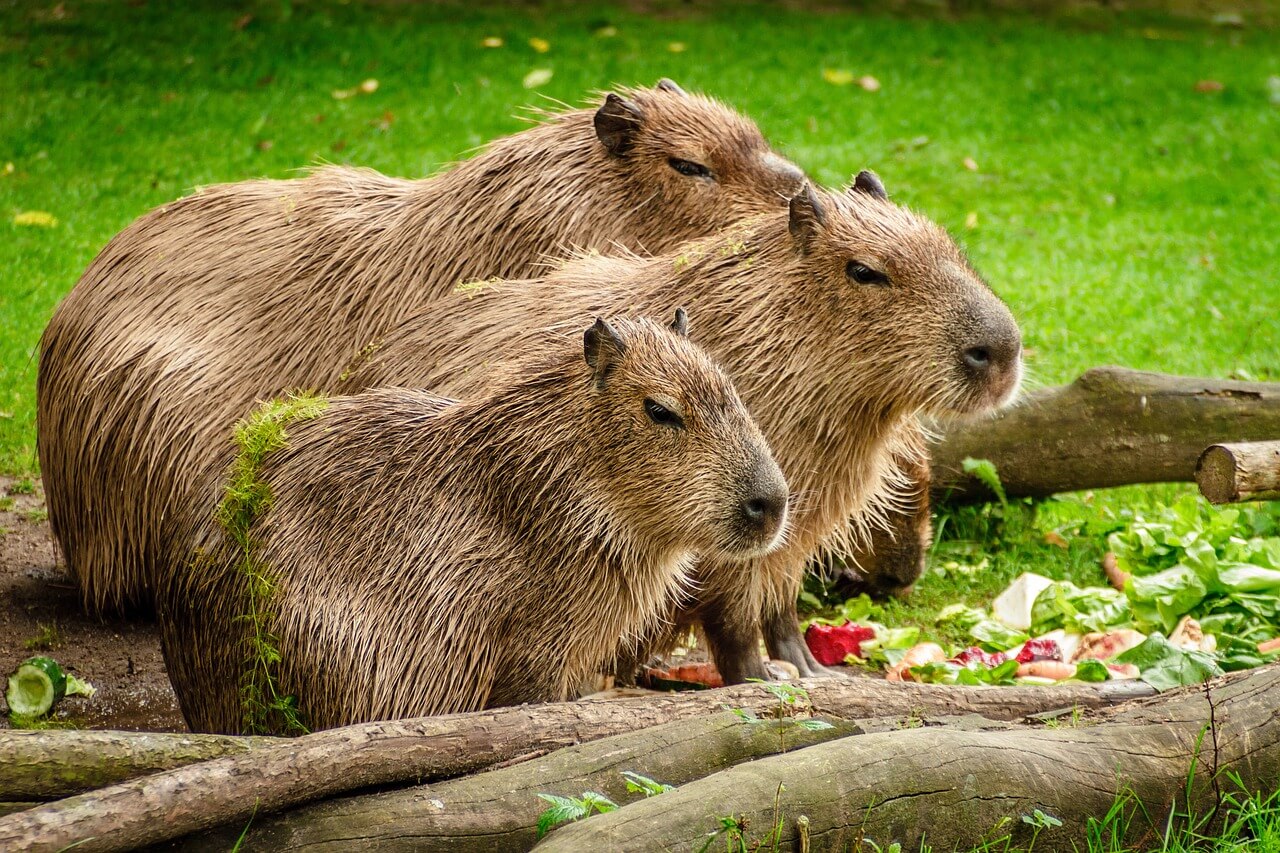
This is none other than the largest rodent on the planet. It’s native to South America and it can grow up to 1.3 meters long (4.3 feet) and reach weights of 60 kilograms (132 lbs). Its body is quite robust. Its fur is long, rough and usually of a reddish-brown color.
In addition, its slightly webbed feet, together with its ability to last up to 5 minutes underwater, make it a great swimmer. It has a predilection for living near lakes, rivers, marshes, mangroves, and tropical savannahs.
These animals like to live together and they’re quite social. In fact, they reach groups of up to 100 individuals, especially during drought seasons. Their diet is based on a wide consumption of plant species such as grasses, aquatic plants, rice, flowers, and different fruits. The voracity of this Amazonian species is evidenced by its capacity to consume up to 8 pounds per day.
Some research argues that the capybara plays a fundamental role in maintaining soil fertility. This rodent demonstrates its efficiency as a nitrogen recycler by eliminating this element through its urine after feeding. Thus, it returns this nutrient to the soil in just a few hours.
Capybaras are able to reproduce throughout the year. However, most births occur in the rainiest seasons. The gestation period is about 110 days and the female gives birth to 3 to 4 young per year. Their life expectancy in the wild is about 8 to 10 years.
3. Anaconda (Eunectes murinus)
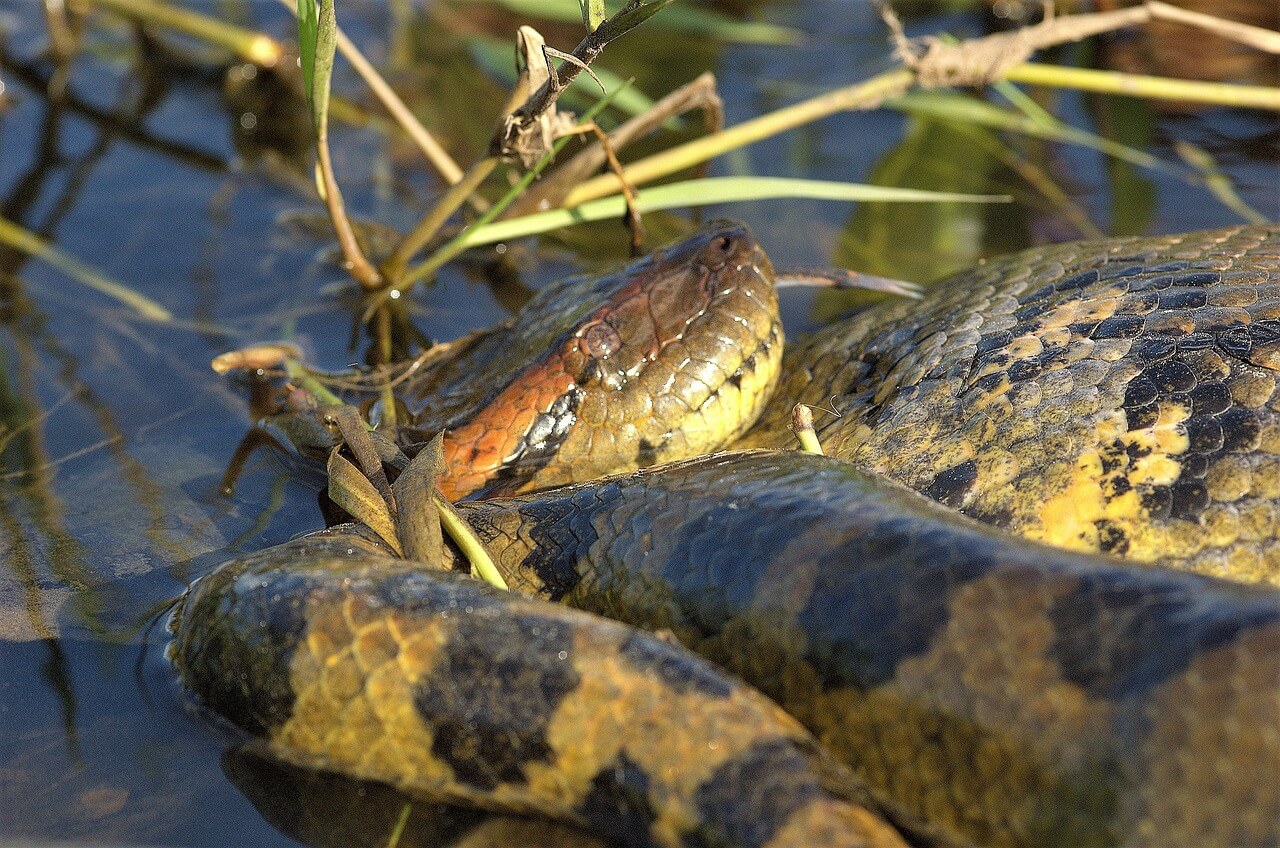
This magnificent animal is endemic to the Amazon, i.e. its distribution is limited to this region. It inhabits the Orinoco, Putumayo, Amazon, Paraguay, and Alto Paraná river basins. It’s also found in tropical rainforests, swamps, and savannahs in countries such as Venezuela, Brazil and Colombia. It can reach more than 10 meters (32 feet) in length and its weight can exceed 2 tons.
This reptile has a carnivorous diet, which includes large and small mammals, birds, and other reptiles. Although it has no venom, it hunts its prey by constriction, which consists of suffocating and exerting pressure on its prey’s rib cage until it suffocates it.
The anaconda is a very skilled swimmer. Indeed, it prefers to hunt its prey in the water, because on land it becomes a bit slow. Although it doesn’t instinctively attack humans, it may do so as a method of defense. Similarly, if it feels threatened by any other predator, lacking bright colors like venomous reptiles, it uses another deterrent technique: noise.
In these cases, its tactic is to curl up into a ball and emit thunderous whistles with its mouth wide open. Thanks to its large lungs, the sounds are loud and deep. In this way, it manages to intimidate predators.
The gestation of this species lasts 6 to 7 months. At the end, the female gives birth to litters of 20 to 40 young. It’s an ovoviviparous animal, i.e., it incubates eggs inside its body, but gives birth to fully-developed snakes.
4. Jaguar (Panthera onca)
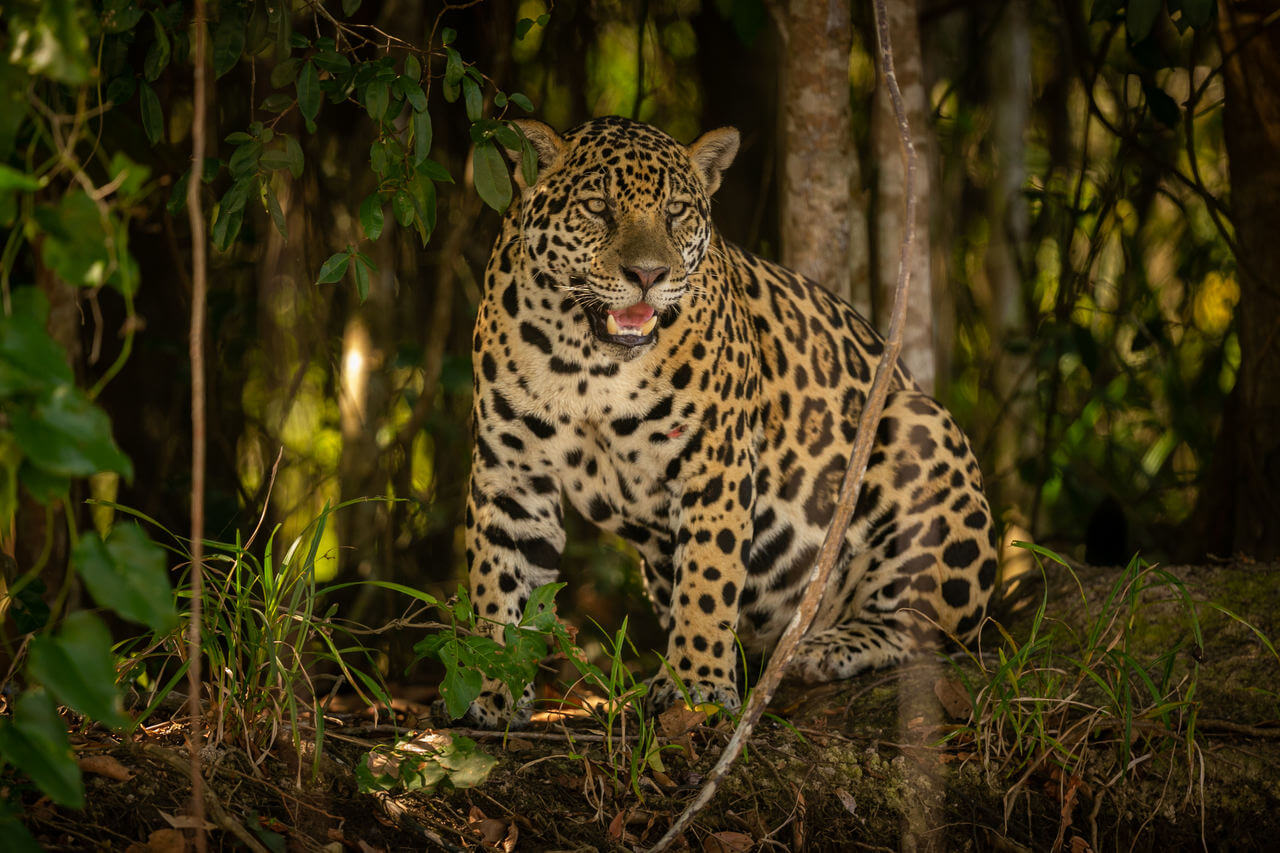
The jaguar is the largest feline in the Americas and the third largest in the world, surpassed only by the lion and the tiger. Its name comes from the Native American term “yajuar“, which means “he who hunts in one leap”.
It’s a robust and muscular animal, whose weight and length can reach 90 kilograms (200 lbs) and 180 centimeters (nearly 6 feet), respectively. It has a very characteristic coat pattern – a golden coat with black spots that run all over its body. This majestic species lives in the tropical jungles and humid forests of the Amazon, in countries such as Colombia, Argentina, and Brazil.
It has a carnivorous diet and among its favorite prey are capybara, tapirs, peccaries and, on some occasions, deer and cows. In addition, unlike other felines, the jaguar has a great affinity for water. Thanks to this, it can hunt other types of animals such as fish, turtles, caimans, and even anacondas.
While most felines kill their prey by asphyxiation, biting their necks, the Panthera onca has a unique method among its species: crushing their skulls. According to an article published in the journal Acta Zoológica Mexicana, the jaguar has one of the most powerful bites in the animal kingdom. In fact, it’s estimated that the force exerted by its canines is 700 kilograms (1540 lbs), enough to break something as hard as the temporal bones of the skull.
The gestation period of females lasts between 93 and 105 days. At the moment of giving birth, it’s common for 2 cubs to be born, which remain with their mother until they’re 2 years old.
5. Poison dart frog (Dendrobatidae)
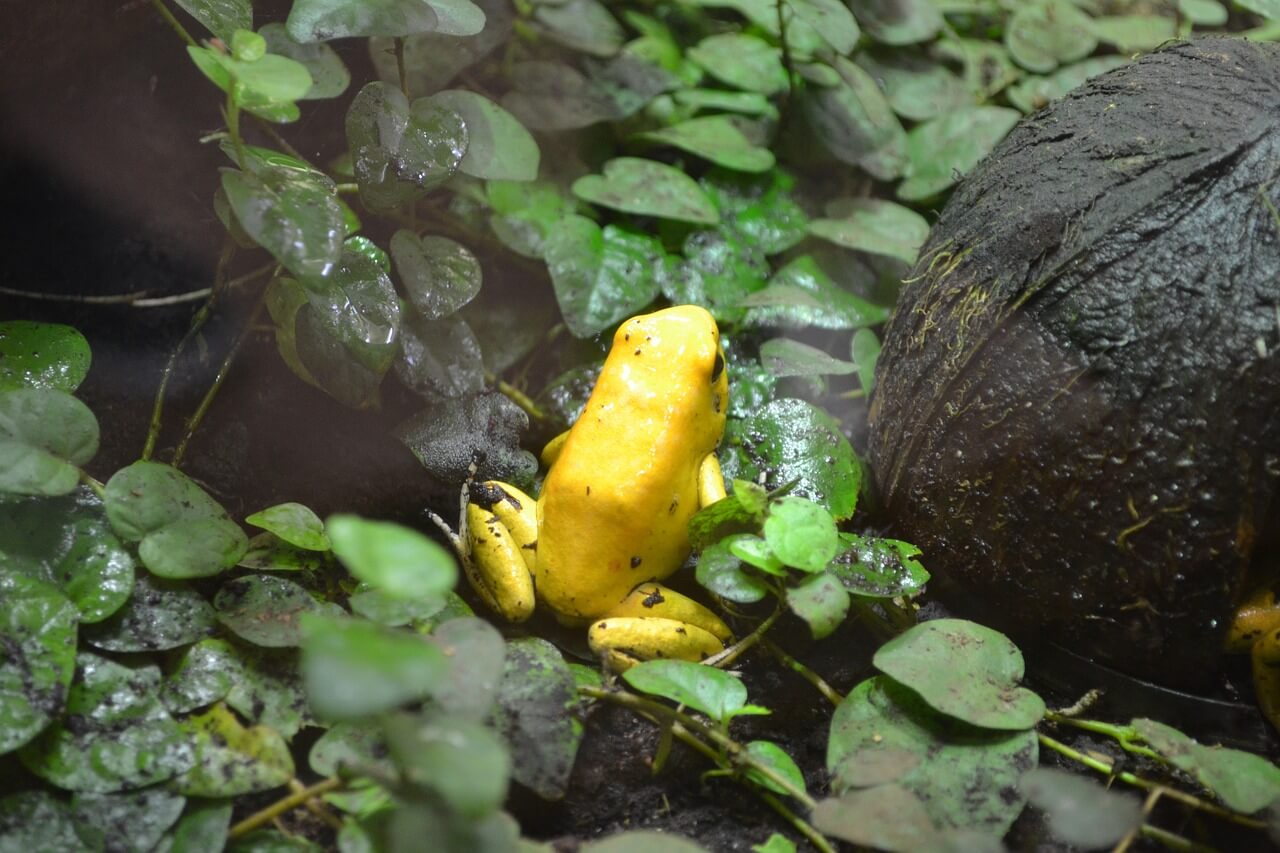
Dendrobatidae is a family of amphibians composed of 203 species of poison frogs. They are also known as arrow or dart frogs. According to legends, the indigenous people of the Amazon rubbed them with their weapons to make them toxic.
As adults, these amphibians barely reach 2 to 5 centimeters in length (1 to 2 inches), depending on the species. They’re characterized by exhibiting strong and vivid colors on their skin, with shades ranging from orange to red, yellow, or blue. This phenomenon is known as aposematic coloration. It’s a method that alerts their predators to the poison in their bodies.
However, these toxic compounds aren’t produced by the frogs themselves, but are obtained by consuming insects such as ants, termites, and beetles. This is explained in a publication in the journal PLoS One.
These toxins or poisonous alkaloids that the arthropods have don’t have harmful effects on arrow or dart frogs, so they accumulate continuously in their skin.
This family of amphibians is endemic to Central and South America, with a greater presence in the Colombian and Brazilian Amazon. In fact, Colombia is home to the most venomous animal on the planet: the golden dart frog (pictured above).
This small amphibian, barely 55 millimeters long (around 2 inches), possesses the alkaloid “batrachotoxin” and is able to produce enough venom to kill ten adult males.
As for reproduction, dendrobatids participate in the rearing of their young. This is a behavior rarely seen among amphibians. Also, unlike other frogs, arrowheads are diurnal. They’re usually found in groups of several individuals.
6. Pirarucu (Arapaima gigas)
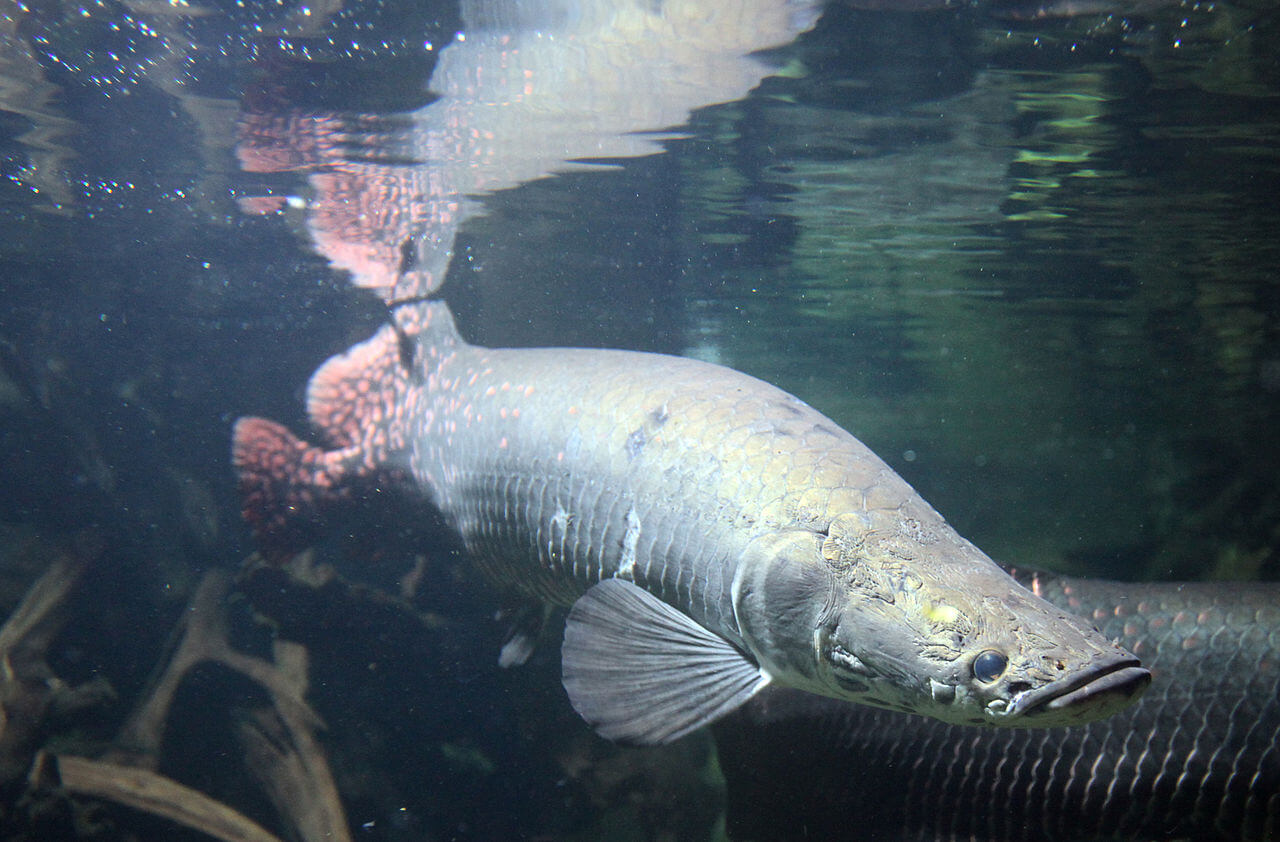
This living fossil is the second-largest freshwater fish on the planet. It is believed to have existed since the Miocene epoch, approximately 23 million years ago. It can exceed 3 meters (9.8 feet) in length and 200 kilograms (440 lbs) in weight, making the pirarucu one of the most emblematic animals of the Amazon.
Among all its characteristics, it stands out for its ability to breathe atmospheric air. A study in the journal The Journal of Experimental Biology specifies that, at certain times of the year, this fish is forced to live in waters with very low oxygen levels. Because of this, its swim bladder evolved into an organ, similar to a human lung, giving it the ability to assimilate oxygen from the atmosphere.
However, as a forced air breather, the pirarucu can’t stay more than 10 to 20 minutes underwater. However, when in danger, it can endure up to 40 minutes.
The pirarucu is found in the Amazon basin of countries such as Ecuador, Brazil and Colombia. Its diet is based on small fish that it catches by simply opening its large mouth. It also has the ability to jump out of the water and hunt other prey such as birds, lizards, and even small primates.
Among other things, in this species occurs what is known as oral incubation. The male carries the eggs in his mouth and defends them against any kind of threat. Once hatched, the young are cared for by their parents until they’re old enough to fend for themselves.
7. Bullet ant (Paraponera clavata)
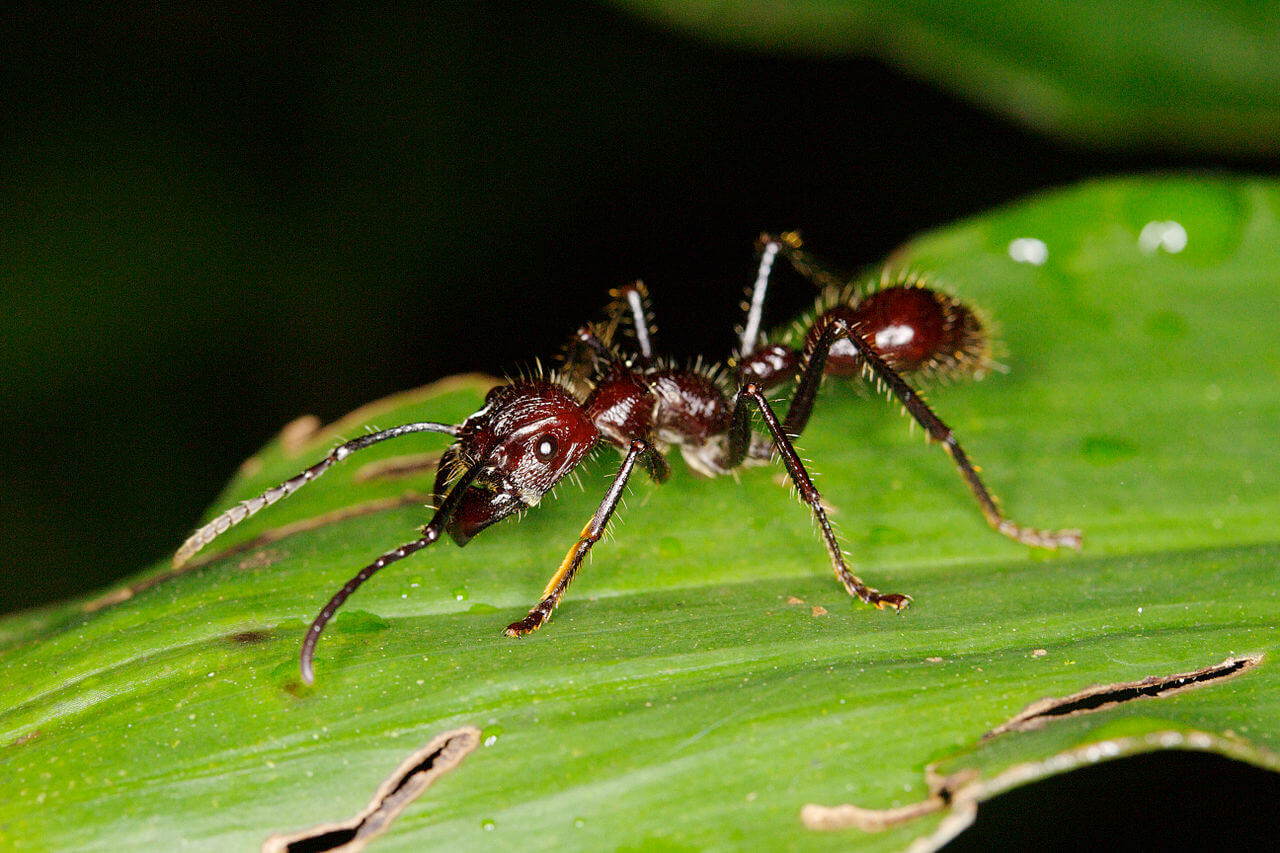
This unique arthropod holds the number 1 spot for the most painful sting in the animal kingdom. In fact, it’s considered one of the most dangerous insects in the entire Amazon. At just 2.5 centimeters (1 inch) long, the bullet ant can inflict 30 times more pain than a wasp.
According to its victims, the sensation of its sting is like being shot. This is because it possesses a neurotoxic peptide known as “poneratoxin“, which has a direct action on pain receptors. It’s also capable of blocking synaptic transmission in the central nervous system.
In addition, this poison destroys red blood cells, erythema, localized edema, sweating, tachycardia, and, in the most extreme cases, anaphylactic shock and respiratory paralysis.
Despite this, an Amazonian tribe known as the Sateré-Mawe, uses the bullet ant as part of one of their ancestral rites, where young men entering puberty must demonstrate their courage and manhood. This ceremony consists of introducing a considerable number of ants inside gloves woven with tree leaves.
Afterwards, they’re placed on children of about 9 years of age, and they have to resist the stings for 10 minutes. According to the indigenous community, this is done in order to immunize the youngsters against the bullet ant’s toxin, since it’s common to be bitten in the Amazon jungle.
This particular insect is found in the river forests of the Venezuelan, Colombian and Brazilian Amazon. It feeds on other insects such as termites and the sap emanating from trees. Its social structure is composed of a queen in charge of reproduction and several workers who care for, sustain and defend the anthill.
Protecting the Amazon and its great diversity
According to several organizations, such as the International Union for Conservation of Nature (IUCN), many of the species that inhabit the Amazon are at serious risk. In fact, in the Red List of Endangered Species, elaborated by the aforementioned organization, the pink dolphin appears as an animal “in danger” of extinction.
As a result of the destruction of ecosystems, indiscriminate hunting, contamination of water resources and illegal trafficking, animals such as the jaguar have seen their population decrease by almost 55% during the last century.
Consequently, we need to become aware of such an important issue. The Amazon must be protected and conserved by all the people who inhabit this planet. Small actions such as avoiding the purchase of wild animals can make a difference, as well as taking care of water resources and rejecting all types of deforestation in the region.
Ranked as one of the 7 natural wonders on our planet, the Amazon covers almost 40% of the entire southern region of the American continent. It extends to 9 different countries, and is home to about 10% of the planet’s biodiversity known so far.
In this article, we’ll explore the bodily characteristics, habitat, abilities, and feeding habits, as well as the reproduction of some of the most representative animal species of the Amazon. Don’t miss it!
The most representative animals of the Amazon
The world’s largest tropical forest is home to about 425 species of mammals, 427 amphibians, 371 reptiles, 1,300 birds, and at least 2,406 fish. This is according to the Amazon Assessment Report 2021, which states that these numbers are approximate underestimates of the true richness of the Amazon.
This report warns that the rate of discovery of new species of animals and plants is quite high: one every two days. Here are some of the mammals, reptiles, amphibians, and insects that are considered the most iconic of this great region of the planet, due to their peculiarities and popularity.
1. Pink river dolphin (Inia geoffrensis)

This is the largest and most intelligent species of freshwater dolphin in existence. As adults, they can reach 2.5 meters (6.5 feet) in length and 200 kilograms (440 lbs) in weight.
Unlike their oceanic cousins, this cetacean has very different physical characteristics. On the one hand, its head is larger and its snout is much longer and pointed. In addition, since their cervical vertebrae aren’t fused, they can turn their heads through 180°.
The most outstanding aspect of this species is the coloration of its body, with gray and, above all, pink tones. At birth, these dolphins are gray, but acquire the pink color as they reach adulthood. Although the origin of this phenomenon isn’t clear, the most accepted theory indicates that it’s a product of the wear and tear of the skin over the years.
Its habitat within the Amazon basin is located between the fluvial systems of the Orinoco River and the upper reaches of the Madeira River in Bolivia. They feed on up to 43 different fish species such as piranhas, catfish, and corvina.
Due to the turbidity of the water in these areas, pink dolphins locate their prey by echolocation. According to a study in the Journal of Experimental Biology, these animals emit short-range and high-frequency sound waves through their clicks.
Regarding reproduction, females give birth to a single calf after 12 months of gestation. The dolphin remains with its mother for at least 2 years. In nature, its life expectancy can be up to 30 years.
2. Capybara (Hydrochoerus hydrochaeris)

This is none other than the largest rodent on the planet. It’s native to South America and it can grow up to 1.3 meters long (4.3 feet) and reach weights of 60 kilograms (132 lbs). Its body is quite robust. Its fur is long, rough and usually of a reddish-brown color.
In addition, its slightly webbed feet, together with its ability to last up to 5 minutes underwater, make it a great swimmer. It has a predilection for living near lakes, rivers, marshes, mangroves, and tropical savannahs.
These animals like to live together and they’re quite social. In fact, they reach groups of up to 100 individuals, especially during drought seasons. Their diet is based on a wide consumption of plant species such as grasses, aquatic plants, rice, flowers, and different fruits. The voracity of this Amazonian species is evidenced by its capacity to consume up to 8 pounds per day.
Some research argues that the capybara plays a fundamental role in maintaining soil fertility. This rodent demonstrates its efficiency as a nitrogen recycler by eliminating this element through its urine after feeding. Thus, it returns this nutrient to the soil in just a few hours.
Capybaras are able to reproduce throughout the year. However, most births occur in the rainiest seasons. The gestation period is about 110 days and the female gives birth to 3 to 4 young per year. Their life expectancy in the wild is about 8 to 10 years.
3. Anaconda (Eunectes murinus)

This magnificent animal is endemic to the Amazon, i.e. its distribution is limited to this region. It inhabits the Orinoco, Putumayo, Amazon, Paraguay, and Alto Paraná river basins. It’s also found in tropical rainforests, swamps, and savannahs in countries such as Venezuela, Brazil and Colombia. It can reach more than 10 meters (32 feet) in length and its weight can exceed 2 tons.
This reptile has a carnivorous diet, which includes large and small mammals, birds, and other reptiles. Although it has no venom, it hunts its prey by constriction, which consists of suffocating and exerting pressure on its prey’s rib cage until it suffocates it.
The anaconda is a very skilled swimmer. Indeed, it prefers to hunt its prey in the water, because on land it becomes a bit slow. Although it doesn’t instinctively attack humans, it may do so as a method of defense. Similarly, if it feels threatened by any other predator, lacking bright colors like venomous reptiles, it uses another deterrent technique: noise.
In these cases, its tactic is to curl up into a ball and emit thunderous whistles with its mouth wide open. Thanks to its large lungs, the sounds are loud and deep. In this way, it manages to intimidate predators.
The gestation of this species lasts 6 to 7 months. At the end, the female gives birth to litters of 20 to 40 young. It’s an ovoviviparous animal, i.e., it incubates eggs inside its body, but gives birth to fully-developed snakes.
4. Jaguar (Panthera onca)

The jaguar is the largest feline in the Americas and the third largest in the world, surpassed only by the lion and the tiger. Its name comes from the Native American term “yajuar“, which means “he who hunts in one leap”.
It’s a robust and muscular animal, whose weight and length can reach 90 kilograms (200 lbs) and 180 centimeters (nearly 6 feet), respectively. It has a very characteristic coat pattern – a golden coat with black spots that run all over its body. This majestic species lives in the tropical jungles and humid forests of the Amazon, in countries such as Colombia, Argentina, and Brazil.
It has a carnivorous diet and among its favorite prey are capybara, tapirs, peccaries and, on some occasions, deer and cows. In addition, unlike other felines, the jaguar has a great affinity for water. Thanks to this, it can hunt other types of animals such as fish, turtles, caimans, and even anacondas.
While most felines kill their prey by asphyxiation, biting their necks, the Panthera onca has a unique method among its species: crushing their skulls. According to an article published in the journal Acta Zoológica Mexicana, the jaguar has one of the most powerful bites in the animal kingdom. In fact, it’s estimated that the force exerted by its canines is 700 kilograms (1540 lbs), enough to break something as hard as the temporal bones of the skull.
The gestation period of females lasts between 93 and 105 days. At the moment of giving birth, it’s common for 2 cubs to be born, which remain with their mother until they’re 2 years old.
5. Poison dart frog (Dendrobatidae)

Dendrobatidae is a family of amphibians composed of 203 species of poison frogs. They are also known as arrow or dart frogs. According to legends, the indigenous people of the Amazon rubbed them with their weapons to make them toxic.
As adults, these amphibians barely reach 2 to 5 centimeters in length (1 to 2 inches), depending on the species. They’re characterized by exhibiting strong and vivid colors on their skin, with shades ranging from orange to red, yellow, or blue. This phenomenon is known as aposematic coloration. It’s a method that alerts their predators to the poison in their bodies.
However, these toxic compounds aren’t produced by the frogs themselves, but are obtained by consuming insects such as ants, termites, and beetles. This is explained in a publication in the journal PLoS One.
These toxins or poisonous alkaloids that the arthropods have don’t have harmful effects on arrow or dart frogs, so they accumulate continuously in their skin.
This family of amphibians is endemic to Central and South America, with a greater presence in the Colombian and Brazilian Amazon. In fact, Colombia is home to the most venomous animal on the planet: the golden dart frog (pictured above).
This small amphibian, barely 55 millimeters long (around 2 inches), possesses the alkaloid “batrachotoxin” and is able to produce enough venom to kill ten adult males.
As for reproduction, dendrobatids participate in the rearing of their young. This is a behavior rarely seen among amphibians. Also, unlike other frogs, arrowheads are diurnal. They’re usually found in groups of several individuals.
6. Pirarucu (Arapaima gigas)

This living fossil is the second-largest freshwater fish on the planet. It is believed to have existed since the Miocene epoch, approximately 23 million years ago. It can exceed 3 meters (9.8 feet) in length and 200 kilograms (440 lbs) in weight, making the pirarucu one of the most emblematic animals of the Amazon.
Among all its characteristics, it stands out for its ability to breathe atmospheric air. A study in the journal The Journal of Experimental Biology specifies that, at certain times of the year, this fish is forced to live in waters with very low oxygen levels. Because of this, its swim bladder evolved into an organ, similar to a human lung, giving it the ability to assimilate oxygen from the atmosphere.
However, as a forced air breather, the pirarucu can’t stay more than 10 to 20 minutes underwater. However, when in danger, it can endure up to 40 minutes.
The pirarucu is found in the Amazon basin of countries such as Ecuador, Brazil and Colombia. Its diet is based on small fish that it catches by simply opening its large mouth. It also has the ability to jump out of the water and hunt other prey such as birds, lizards, and even small primates.
Among other things, in this species occurs what is known as oral incubation. The male carries the eggs in his mouth and defends them against any kind of threat. Once hatched, the young are cared for by their parents until they’re old enough to fend for themselves.
7. Bullet ant (Paraponera clavata)

This unique arthropod holds the number 1 spot for the most painful sting in the animal kingdom. In fact, it’s considered one of the most dangerous insects in the entire Amazon. At just 2.5 centimeters (1 inch) long, the bullet ant can inflict 30 times more pain than a wasp.
According to its victims, the sensation of its sting is like being shot. This is because it possesses a neurotoxic peptide known as “poneratoxin“, which has a direct action on pain receptors. It’s also capable of blocking synaptic transmission in the central nervous system.
In addition, this poison destroys red blood cells, erythema, localized edema, sweating, tachycardia, and, in the most extreme cases, anaphylactic shock and respiratory paralysis.
Despite this, an Amazonian tribe known as the Sateré-Mawe, uses the bullet ant as part of one of their ancestral rites, where young men entering puberty must demonstrate their courage and manhood. This ceremony consists of introducing a considerable number of ants inside gloves woven with tree leaves.
Afterwards, they’re placed on children of about 9 years of age, and they have to resist the stings for 10 minutes. According to the indigenous community, this is done in order to immunize the youngsters against the bullet ant’s toxin, since it’s common to be bitten in the Amazon jungle.
This particular insect is found in the river forests of the Venezuelan, Colombian and Brazilian Amazon. It feeds on other insects such as termites and the sap emanating from trees. Its social structure is composed of a queen in charge of reproduction and several workers who care for, sustain and defend the anthill.
Protecting the Amazon and its great diversity
According to several organizations, such as the International Union for Conservation of Nature (IUCN), many of the species that inhabit the Amazon are at serious risk. In fact, in the Red List of Endangered Species, elaborated by the aforementioned organization, the pink dolphin appears as an animal “in danger” of extinction.
As a result of the destruction of ecosystems, indiscriminate hunting, contamination of water resources and illegal trafficking, animals such as the jaguar have seen their population decrease by almost 55% during the last century.
Consequently, we need to become aware of such an important issue. The Amazon must be protected and conserved by all the people who inhabit this planet. Small actions such as avoiding the purchase of wild animals can make a difference, as well as taking care of water resources and rejecting all types of deforestation in the region.
All cited sources were thoroughly reviewed by our team to ensure their quality, reliability, currency, and validity. The bibliography of this article was considered reliable and of academic or scientific accuracy.
- Arteaga, M., & Jorgenson, J. (2007). Hábitos de desplazamiento y dieta del capibara (Hydrochoerus hydrochaeris) en la Amazonia colombiana. Mastozoología Neotropical, 14 (1). https://www.redalyc.org/pdf/457/45714102.pdf
- Brauner, C. J., Matey, V., Wilson, J. M., Bernier, N. J., & Val, A. L. (2004). Transition in organ function during the evolution of air-breathing; insights from Arapaima gigas, an obligate air-breathing teleost from the Amazon. The Journal of Experimental Biology, 207 (Pt 9), 1433–1438. https://journals.biologists.com/jeb/article/207/9/1433/15223/Transition-in-organ-function-during-the-evolution
- Da Silva, V., Trujillo, F., Martin, A., Zerbini, A.N., Crespo, E., Aliaga-Rossel, E. & Reeves, R. (2018). Inia geoffrensis. The IUCN Red List of Threatened Species 2018. https://www.iucnredlist.org/species/10831/50358152
- De Andrés, J. (2019). El delfín que tiñe de rosa el Amazonas. The National Museum of Natural Sciences. https://www.researchgate.net/publication/334507944_El_delfin_que_tine_de_rosa_el_Amazonas
- Johnson, S. R., Rikli, H. G., Schmidt, J. O., & Evans, M. S. (2017). A reexamination of poneratoxin from the venom of the bullet ant Paraponera clavata. Peptides, 98, 51–62. https://www.sciencedirect.com/science/article/abs/pii/S019697811630119X?via%3Dihub
- Ladegaard, M., Jensen, F. H., de Freitas, M., Ferreira da Silva, V. M., & Madsen, P. T. (2015). Amazon river dolphins (Inia geoffrensis) use a high-frequency short-range biosonar. The Journal of Experimental Biology, 218(Pt 19), 3091–3101. https://journals.biologists.com/jeb/article/218/19/3091/14177/Amazon-river-dolphins-Inia-geoffrensis-use-a-high
- Mancera Rodríguez, N., & Reyes O. (2008). Comercio de fauna silvestre en Colombia. Revista Facultad Nacional de Agronomía Medellín, 61(2). https://www.redalyc.org/articulo.oa?id=179915376015
- Moskowitz, N. A., D’Agui, R., Alvarez-Buylla, A., Fiocca, K., & O’Connell, L. A. (2022). Poison frog dietary preference depends on prey type and alkaloid load. PloS One, 17(12), e0276331. https://www.ncbi.nlm.nih.gov/pmc/articles/PMC9714857/
- Monteiro de Carvalho, J. (2019). Ritual de passagem das terras indígenas às áreas urbanas dos Sateré-Mawé. Editora UEA. http://repositorioinstitucional.uea.edu.br/bitstream/riuea/1566/1/Ritual%20de%20passagem%20das%20terras%20ind%C3%ADgenas%20%C3%A0s%20%C3%A1reas%20urbanas%20dos%20Sater%C3%A9-Maw%C3%A9.pdf
- Moskowitz, N. A., D’Agui, R., Alvarez-Buylla, A., Fiocca, K., & O’Connell, L. A. (2022). Poison frog dietary preference depends on prey type and alkaloid load. PloS One, 17(12). https://www.ncbi.nlm.nih.gov/pmc/articles/PMC9714857/
- National Geographic en Español. (2021, 15 de noviembre). El delfín rosado del Amazonas se extinguirá en menos de 50 años, revela un estudio. Consultado el 15 de mayo de 2023. https://www.ngenespanol.com/animales/conoce-al-delfin-rosado/
- Sachetti, J., Lameda, F., Vasquez J., & Zenteno, R. (2011). Fuerza de mordedura y estrés mandibular en el jaguar (Panthera onca) durante la depredación de pecaríes (Artiodactyla: Tayassuidae) mediante la fractura de sus cráneos. Acta Zoológica Mexicana, 27 (3). https://www.redalyc.org/articulo.oa?id=57521382009
- Sahibdeen, R. (2011). Eunectes murinus- Green Anaconda or Huille. The online Guide to The Animals of Trinidad and Tobago. https://www.researchgate.net/publication/330423736_Eunectes_murinus_-_Green_Anaconda_or_Huille
- Zapata-Ríos, G., Andreazzi, C. S., Carnaval, A. C., Rodrigues da Costa Doria, C., Duponchelle, F., Flecker, A., Guayasamin, J. M., Heilpern, S., Jenkins, C. N., Maldonado, C., Meneghelli, D., Miranda, G., Moraes R., M., Silman, M., Pinheiro de Almeida Silveira, M. A., Tabet, G., Trujillo, F., Ulloa Ulloa, C., & Arieira, J. (2021). Chapter 3: Biological diversity and ecological networks in the Amazon. Amazon Assessment Report 2021. UN Sustainable Development Solutions Network (SDSN). https://www.theamazonwewant.org/wp-content/uploads/2022/06/Chapter-3-Bound-May-9.pdf
This text is provided for informational purposes only and does not replace consultation with a professional. If in doubt, consult your specialist.








